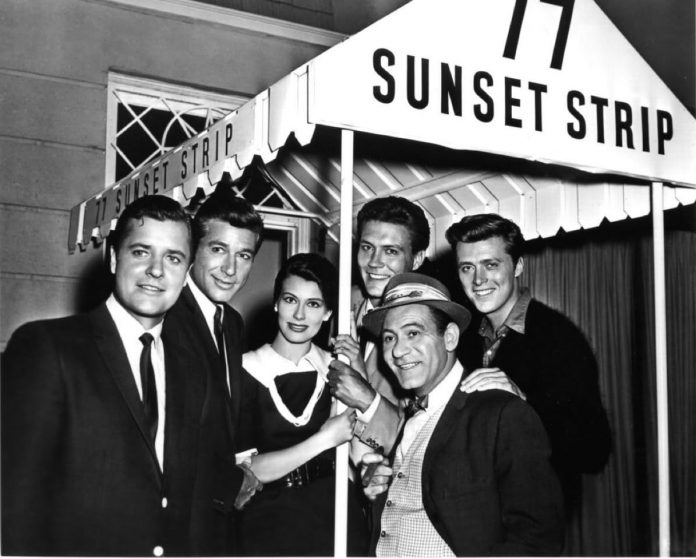Jazz Journal readers will have noted recent reviews of films released in the 1950s. Films such as Pete Kelly’s Blues and Anatomy Of A Murder had strong connections with jazz – the former was actually centred on a jazz ensemble whilst the latter boasted a score by Duke Ellington. But jazz featured well on the small screen too in the same period: three television series from the end of the decade – two that debuted in 1958, one in 1959 – had jazz as a principal ingredient.
There’s a term paper waiting to be written on the close links between jazz and crime. The link is hardly surprising given the fact that many jazz clubs were owned virtually exclusively by gangsters, either blatantly or discreetly. So it’s not unnatural that the three shows in question all feature private detectives. Two of the three, Peter Gunn and Johnny Staccato, take their titles from the eponymous heroes played by Craig Stevens and John Cassavetes respectively. The third is named from the address where not one but two private eyes – Stu Bailey (Efrem Zimbalist) and Jeff Spencer (Roger Smith) have their office, 77 Sunset Strip. The office building is right next door to Dino’s Lodge, the very real restaurant owned by Dean Martin where the house band – which featured in 33 episodes – is the celebrated Frankie Ortega Trio. The valet parking attendant at Dino’s Gerald Lloyd “Kookie” Kookson (Ed Byrnes) contrived to become involved each week and was eventually made a partner.
The 77 Sunset Strip format was so successful – the show ran for six series – that Warner’s created three similar shows – Hawaiian Eye, Bourbon Street Beat, and Surfside Six Five 0, all with title songs by Jerry Livingston and Mack David. (This is purely peripheral, but I once spent a delightful afternoon at the North Rodeo Drive home of Jerry Livingston. There were only four of us there; Jerry, his wife Ruth, me, and the mutual friend who, cognisant of my admiration for songwriters, had brokered the meeting. As I was leaving Jerry graciously asked if, as a memento, I would like him to sign some of his sheet music. This was not unlike asking Billy Bunter if he fancied a cream bun. I would never have presumed to ask but I jumped at the chance and still own signed copies of some half dozen standards including 77 Sunset Strip).
Technically speaking, 77 Sunset Strip was the second of the three to reach the screen. It did so some 16 days after Peter Gunn, which had arguably superior credits. Peter Gunn was created by Blake Edwards, who also produced 114 episodes, wrote 113 and directed 10. The music was composed by Henry Mancini and played by the cream of West Coast session musicians including Shelly Manne, Milt Bernhart, Larry Bunker, Conrad Gozzo, Jack Sheldon, Laurindo Almeida, Dick Nash, Ted Nash and Shorty Rogers. The subsequent album was the first to win the Grammy for album of the year. This was, we must remember, 1958, and neither Blake Edwards nor Henry Mancini was as celebrated as they both later became – and when they were so it was for material light years away from “cool” private eyes and super-cool West Coast jazz; for example, the following year they worked together again but this time on the big screen when Edwards directed and Mancini scored Breakfast At Tiffany’s, winning a Best Song Oscar for Moon River. In 1963 they collaborated yet again for an equally popular big-screen movie The Pink Panther. The point is that once again neither the title song, The Pink Panther Theme, nor the other catchy stand-alone number Megliore Stasera (It Had Better Be Tonight) was anything like Sorta Blue, Dreamsville, A Profound Gass, The Brothers Go To Mothers, The Floater, Not From Dixie, and, of course, Peter Gunn itself. In retrospect therefore it is fitting that this show was first on the air because Peter Gunn was definitely the first show to feature jazz extensively on the small screen.
The last of the three shows to reach the public – in September, 1959 – was the shortest lived – one season only, 27 episodes – but considered by many the best of the bunch. Johnny Staccato starred John Cassavetes as the eponymous Staccato, a jazz pianist who moonlights as a private eye. Cassavetes, who also directed five episodes, was indisputably the most accomplished leading actor in all three shows. In support, Ischia-born Eduardo Cianelli, who made a very respectable living playing Italian gangsters, lent a definite air of authenticity as he played the owner of Waldo’s Greenwich Village jazz club, where Staccato hangs out between solving homicides. Although firmly set in Manhattan, the series was shot in LA and all the prominently featured musicians – including Shelly Manne, Pete Candoli, Barney Kessel, Red Mitchell, Mel Lewis and Red Norvo – were linked strongly to the West Coast school.
Of all the actors in the three shows John Cassavetes arguably had the closest connection to jazz. In 1961 he wrote and directed the feature film Too Late Blues about an idealistic jazz pianist who would rather make music in the public park than play commercial pap for money.
These three shows show what a significant contribution the small screen made to the cause of jazz. Perhaps through vagaries of distribution and locale it has been overshadowed by its big brother.
















